10 temple budha
1.borobudurBorobudurCharacteristics of it: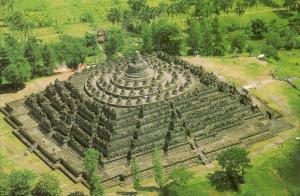 Borobudur-shaped punden, which consists of six levels of a square, three levels of a circular and a main stupa as a peak. Also scattered in all levels-the levels several stupas.Borobudur is the name of a Buddhist temple located at Borobudur, Magelang, Central Java. Location of the temple is approximately 100 km southwest of Semarang and 40 km northwest of Yogyakarta. This temple
Borobudur-shaped punden, which consists of six levels of a square, three levels of a circular and a main stupa as a peak. Also scattered in all levels-the levels several stupas.Borobudur is the name of a Buddhist temple located at Borobudur, Magelang, Central Java. Location of the temple is approximately 100 km southwest of Semarang and 40 km northwest of Yogyakarta. This temple was founded by the Mahayana Buddhists around the year 800 AD during the early reign of Sailendra dynasty.2. Menduttemple-Mendut
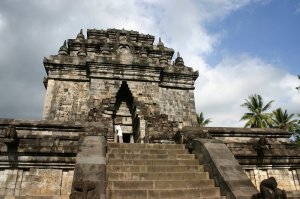 Characteristics of it:Decoration found on Mendut form a criss-cross decoration. Decorated with carved celestial beings such as Angels and fairies, two monkeys and an eagle.Mendut background is a Buddhist temple. The
temple is situated in the village Mendut, Mungkid district, Magelang
regency, Central Java, a few kilometers from Borobudur temple.Mendut was founded during the reign of King Indra of Sailendra dynasty. In
the inscription Karangtengah that bertarikh 824 AD, mentioned that the
king Indra has built a shrine named Veluvana which means bamboo forests.
By a Dutch archeologist named J.G. de Casparis, it was associated with Mendut.3. Candi NgawenNgawenCharacteristics of it:The
temple consists of 5 pieces of small temples, two of which have
different shapes decorated by statues of lions at the four corners. A statue of Buddha in a sitting position Ratnasambawa who had no head appears to be on one of the other temples. Some relief on the side of the temple still seems quite clear, among which are carved kinnaras, Kinnari, and kala-makara.
Characteristics of it:Decoration found on Mendut form a criss-cross decoration. Decorated with carved celestial beings such as Angels and fairies, two monkeys and an eagle.Mendut background is a Buddhist temple. The
temple is situated in the village Mendut, Mungkid district, Magelang
regency, Central Java, a few kilometers from Borobudur temple.Mendut was founded during the reign of King Indra of Sailendra dynasty. In
the inscription Karangtengah that bertarikh 824 AD, mentioned that the
king Indra has built a shrine named Veluvana which means bamboo forests.
By a Dutch archeologist named J.G. de Casparis, it was associated with Mendut.3. Candi NgawenNgawenCharacteristics of it:The
temple consists of 5 pieces of small temples, two of which have
different shapes decorated by statues of lions at the four corners. A statue of Buddha in a sitting position Ratnasambawa who had no head appears to be on one of the other temples. Some relief on the side of the temple still seems quite clear, among which are carved kinnaras, Kinnari, and kala-makara.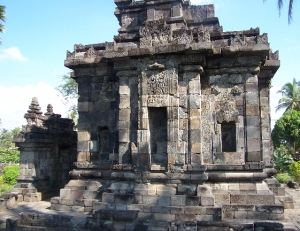 Ngawen
temple is a Buddhist temple located approximately 5 km before Mendut of
Yogyakarta direction, ie in the village Ngawen, Muntilan subdistrict,
Magelang. According
to estimates, this temple was built by the Sailendra dynasty in the 8th
century in the days of the Ancient Mataram Kingdom. The existence of this Ngawen temple is that the most likely in the Middle Reef inscription in the year 824 AD4. Candi Lumbungtemple-barn
Ngawen
temple is a Buddhist temple located approximately 5 km before Mendut of
Yogyakarta direction, ie in the village Ngawen, Muntilan subdistrict,
Magelang. According
to estimates, this temple was built by the Sailendra dynasty in the 8th
century in the days of the Ancient Mataram Kingdom. The existence of this Ngawen temple is that the most likely in the Middle Reef inscription in the year 824 AD4. Candi Lumbungtemple-barn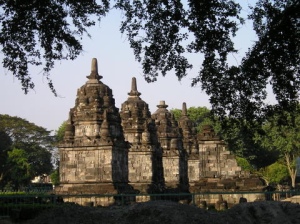 Lumbung Temple is a Buddhist temple complex located in the Prambanan Temple Tourism Park, which is next to the temple Bubrah. According to estimates, this temple was built in the 9th century at the time of the Ancient Mataram Kingdom. This temple is a collection of the main temples (Buddhist temple themed)Characteristics:Surrounded by 16 small temples that the situation is still relatively good.5. Candi Banyunibo
Lumbung Temple is a Buddhist temple complex located in the Prambanan Temple Tourism Park, which is next to the temple Bubrah. According to estimates, this temple was built in the 9th century at the time of the Ancient Mataram Kingdom. This temple is a collection of the main temples (Buddhist temple themed)Characteristics:Surrounded by 16 small temples that the situation is still relatively good.5. Candi Banyunibo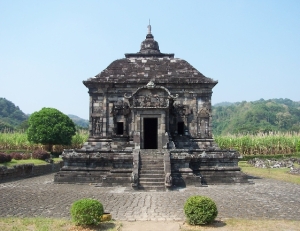 temple-BanyuniboBanyunibo
temple which means water falling-drip (in Javanese) is a Buddhist
temple located not far from Candi Ratu Boko, which is at the east of the
city of Yogyakarta city towards Wonosari. This temple was built in the 9th century during the time of the Ancient Mataram Kingdom. At the top of the temple there is a stupa that are characteristic of Buddhism.Characteristics:Circumstances
of this temple still looks pretty solid and intact with kala-makara
relief carvings and other forms of relief that still seems very clear. The
temple which has the middle part of the room was first discovered and
repaired back to the 1940s, and now in the middle of the rice-fields.6. Enshrinement complex Batujayacandi_batujaya
temple-BanyuniboBanyunibo
temple which means water falling-drip (in Javanese) is a Buddhist
temple located not far from Candi Ratu Boko, which is at the east of the
city of Yogyakarta city towards Wonosari. This temple was built in the 9th century during the time of the Ancient Mataram Kingdom. At the top of the temple there is a stupa that are characteristic of Buddhism.Characteristics:Circumstances
of this temple still looks pretty solid and intact with kala-makara
relief carvings and other forms of relief that still seems very clear. The
temple which has the middle part of the room was first discovered and
repaired back to the 1940s, and now in the middle of the rice-fields.6. Enshrinement complex Batujayacandi_batujaya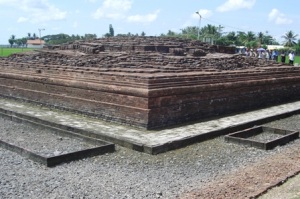 Batujaya
enshrinement complex is a remnant of a complex of ancient Buddhist
enshrinement located in District and Sub Batujaya Pakisjaya, Karawang
regency, West Java Province. The site is called enshrinement because it consists of a set of temples scattered at some point.Traits-characteristics:In terms of quality, Batujaya temple at the site is not complete in general as befits most of the buildings of the temple. The
temple buildings are found only in the legs or base of the building,
but the rest of the buildings on the site Blandongan Temple.The temples are mostly still in the ground mound-shaped hills (also referred to as Unur in Sundanese and Javanese). It turns out these temples do not show the size or height of the same building.7. Muara Takustemple-estuary-TakusBarelang temple is a Buddhist temple located in Riau, Indonesia. This
temple complex is located precisely in the village Barelang, District
XIII Koto Kampar regency or distance of approximately 135 kilometers
from the city of Pekanbaru, Riau. The
distance between the center of the temple complex Barelang village
about 2.5 miles and not far from the edge of Kampar Kanan River.
Batujaya
enshrinement complex is a remnant of a complex of ancient Buddhist
enshrinement located in District and Sub Batujaya Pakisjaya, Karawang
regency, West Java Province. The site is called enshrinement because it consists of a set of temples scattered at some point.Traits-characteristics:In terms of quality, Batujaya temple at the site is not complete in general as befits most of the buildings of the temple. The
temple buildings are found only in the legs or base of the building,
but the rest of the buildings on the site Blandongan Temple.The temples are mostly still in the ground mound-shaped hills (also referred to as Unur in Sundanese and Javanese). It turns out these temples do not show the size or height of the same building.7. Muara Takustemple-estuary-TakusBarelang temple is a Buddhist temple located in Riau, Indonesia. This
temple complex is located precisely in the village Barelang, District
XIII Koto Kampar regency or distance of approximately 135 kilometers
from the city of Pekanbaru, Riau. The
distance between the center of the temple complex Barelang village
about 2.5 miles and not far from the edge of Kampar Kanan River.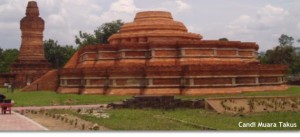 Characteristics:The
temple complex is surrounded by walls measuring 74 x 74 meters there is
also a wall outside their area of land measuring 1.5 x 1.5 kilometers
surrounding this complex sampal to Kampar river Right. Inside the complex there is also an old temple building, temple Stupa and the youngest and Mahligai Palangkaraya. Temple building material composed of sand stone, river stone and brick. According
to local source, the bricks were made in Pongkai village, a village
located on the downstream side of the temple complex. Former mining land for the bricks until now regarded as a highly respected residents. To bring the brick to the temple, done in relay from hand to hand. This
story, although not definitive truth expresses the idea that the
construction of the temple was the work together and done by people
crowded.8. Candi Sumberawantemple-SumberawanSumberawan temple only in the form of a stupa, located in District Singosari. With a distance of about 6 km from Singosari. This temple is a relic of the Kingdom Singhasari and used by Buddhists at that time.The
temple is situated in the village Sumberawan Toyomarto, Singosari,
Malang regency, + / - 6 Km, in the Northwest Singosari, this temple is
made of andesite stone the size of P. 6.25 m L. 6.25 m T. 5.23 m was built at an altitude of 650 meters above sea level, in the foothills of Mount Arjuna. Scenery around the temple is very beautiful because it is located near a lake very clear water. This condition gives the name Rawan temple.
Characteristics:The
temple complex is surrounded by walls measuring 74 x 74 meters there is
also a wall outside their area of land measuring 1.5 x 1.5 kilometers
surrounding this complex sampal to Kampar river Right. Inside the complex there is also an old temple building, temple Stupa and the youngest and Mahligai Palangkaraya. Temple building material composed of sand stone, river stone and brick. According
to local source, the bricks were made in Pongkai village, a village
located on the downstream side of the temple complex. Former mining land for the bricks until now regarded as a highly respected residents. To bring the brick to the temple, done in relay from hand to hand. This
story, although not definitive truth expresses the idea that the
construction of the temple was the work together and done by people
crowded.8. Candi Sumberawantemple-SumberawanSumberawan temple only in the form of a stupa, located in District Singosari. With a distance of about 6 km from Singosari. This temple is a relic of the Kingdom Singhasari and used by Buddhists at that time.The
temple is situated in the village Sumberawan Toyomarto, Singosari,
Malang regency, + / - 6 Km, in the Northwest Singosari, this temple is
made of andesite stone the size of P. 6.25 m L. 6.25 m T. 5.23 m was built at an altitude of 650 meters above sea level, in the foothills of Mount Arjuna. Scenery around the temple is very beautiful because it is located near a lake very clear water. This condition gives the name Rawan temple.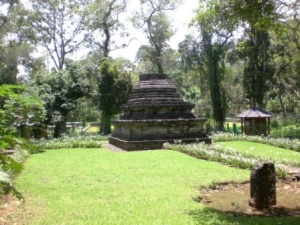 Traits-characteristics:The temple consists of a foot and body-shaped stupa. On the shelf there is a high temple hall, the foot of the temple has the viewer on all four sides. At
the foot of the temple stands a stupa consists of a square pedestal,
and the pedestal is octagonal with Padma pads, being the top of the
bell-shaped (stupa) that a peak has been lost.9. Brahu
Traits-characteristics:The temple consists of a foot and body-shaped stupa. On the shelf there is a high temple hall, the foot of the temple has the viewer on all four sides. At
the foot of the temple stands a stupa consists of a square pedestal,
and the pedestal is octagonal with Padma pads, being the top of the
bell-shaped (stupa) that a peak has been lost.9. Brahu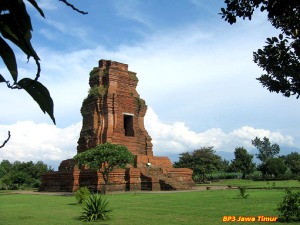 temple-brahu_Brahu built in the style and culture of Buddhism, founded the 15th century AD. Another opinion, this temple is much older than the other temples around Trowulan. According to the book Good Arowana, Brahu word derived from the word Wanaru or Warahu. The
name is derived from the name of a sacred building Alasantan as
mentioned in the inscription, which was found not far from Brahu. Inscriptions written in the year 861 MPU Spoon Saka or 9 September 939,Traits-characteristics:Brahu an incinerator (crematorium) remains the kings of Brawijaya. Surprisingly in the study, there was no one pakarpun who managed to find the bodies in the ashes of the former temple. More over after the temple restoration performed in 1990 and 1995.10. Candi Sewu
temple-brahu_Brahu built in the style and culture of Buddhism, founded the 15th century AD. Another opinion, this temple is much older than the other temples around Trowulan. According to the book Good Arowana, Brahu word derived from the word Wanaru or Warahu. The
name is derived from the name of a sacred building Alasantan as
mentioned in the inscription, which was found not far from Brahu. Inscriptions written in the year 861 MPU Spoon Saka or 9 September 939,Traits-characteristics:Brahu an incinerator (crematorium) remains the kings of Brawijaya. Surprisingly in the study, there was no one pakarpun who managed to find the bodies in the ashes of the former temple. More over after the temple restoration performed in 1990 and 1995.10. Candi Sewu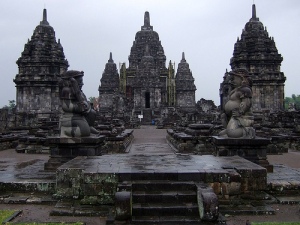 temple-sewuSewu
Temple is a Buddhist temple located in the temple complex of Prambanan
(only a few hundred meters from the main temple Jonggrang). Candi Sewu (thousand) is expected to be built during the ancient Mataram kingdom by King Rakai Panangkaran (746-784). Sewu
Temple is the largest Buddhist temple complex after the temple of
Borobudur, while Jonggrang temple is patterned Hindu temple.According
to local folk legend, the entire temple is numbered 999 and is made by a
powerful character named, Bondowoso in just one night only, as a
prerequisite to be able to marry the goddess Jonggrang. But it failed because of his desire at dawn, the templeamount is still less than one.
temple-sewuSewu
Temple is a Buddhist temple located in the temple complex of Prambanan
(only a few hundred meters from the main temple Jonggrang). Candi Sewu (thousand) is expected to be built during the ancient Mataram kingdom by King Rakai Panangkaran (746-784). Sewu
Temple is the largest Buddhist temple complex after the temple of
Borobudur, while Jonggrang temple is patterned Hindu temple.According
to local folk legend, the entire temple is numbered 999 and is made by a
powerful character named, Bondowoso in just one night only, as a
prerequisite to be able to marry the goddess Jonggrang. But it failed because of his desire at dawn, the templeamount is still less than one.10 temple hindu
1.candi cethocandi_cetho1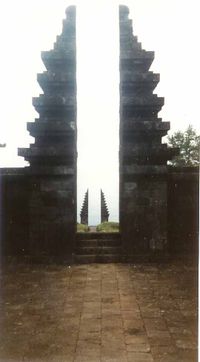 Cetho is a Hindu temple relics patterned end of Majapahit era (15th century). The first scientific report about him made by Van de Vlies in 1842. A.J. Bernet Kempers also do research about it. Excavation
(trenching) for the purposes of reconstruction was first performed in
1928 by the Archaeological Department of the Dutch East Indies. Under the circumstances when the rubble started to study, this temple has the age that does away with Sukuh. Location
of the temple is located in the hamlet of Ceto, Gumeng Village,
District Jenawi, Karanganyar, at an altitude of 1400m above sea level.Characteristics:At its current state, Cetho staircase consists of nine levels. Before the big arch shaped temple briefly, visitors find two pairs of statues guard. The first level after the gate into a courtyard of the temple. The second level is a page here and there petilasan Ki Ageng Krincingwesi, Cetho ancestral hamlet society.2. Candi Asutemple-asuCandi
Asu is the name of a cultural heritage Hindu temple located in the
village of Candi Post, village Sengi, Shaman district, Magelang regency,
Central Java province (approximately 10 km in northeast of the temple
Ngawen). Close by there are also 2 other Hindu temples, the temple and the temple Pendem Lumbung (Magelang). The temple name is a new name given by the surrounding community.
Cetho is a Hindu temple relics patterned end of Majapahit era (15th century). The first scientific report about him made by Van de Vlies in 1842. A.J. Bernet Kempers also do research about it. Excavation
(trenching) for the purposes of reconstruction was first performed in
1928 by the Archaeological Department of the Dutch East Indies. Under the circumstances when the rubble started to study, this temple has the age that does away with Sukuh. Location
of the temple is located in the hamlet of Ceto, Gumeng Village,
District Jenawi, Karanganyar, at an altitude of 1400m above sea level.Characteristics:At its current state, Cetho staircase consists of nine levels. Before the big arch shaped temple briefly, visitors find two pairs of statues guard. The first level after the gate into a courtyard of the temple. The second level is a page here and there petilasan Ki Ageng Krincingwesi, Cetho ancestral hamlet society.2. Candi Asutemple-asuCandi
Asu is the name of a cultural heritage Hindu temple located in the
village of Candi Post, village Sengi, Shaman district, Magelang regency,
Central Java province (approximately 10 km in northeast of the temple
Ngawen). Close by there are also 2 other Hindu temples, the temple and the temple Pendem Lumbung (Magelang). The temple name is a new name given by the surrounding community.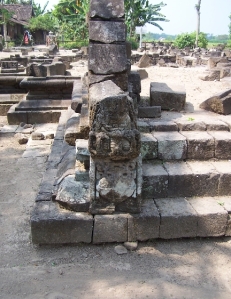 Characteristics:Called
Candi Asu near the temple because it contained cow statue of Nandi, the
vehicle of Lord Shiva statue asu estimated population as 'dogs'. Temple
Barn for allegedly called by locals first place to store rice (another
Lumbung temple at Prambanan temple complex Tourism Park). The
third temple is situated on the banks Pabelan, western slope of Mount
Merapi, in the area of convergence (battle) Pabelan River and River
Tlingsing. The three facing west. Candi Asu square with a size of 7.94 meters. 2.5 meter high temple foot, temple body height of 3.35 meter. High temple roof is unknown because it has collapsed and most of the stones missing. Looking at the third temple can be estimated that the temples that includes a small building. Near
Candi Asu have found two pieces of shaped stone monument inscriptions
(phallus), the inscription Sri Mangala I (874 AD) and Sri Mangala II
(874 M).3. Temple Mount Wukirtemple-mountain-wukirTemple
or Temple Mount Wukir Canggal is a Hindu temple located in the hamlet
Canggal, kalurahan Kadiluwih, Salam subdistrict, Magelang, Central Java.
The temple is precisely located on the hill slopes of Mount Merapi Wukir on the border of Central Java and Yogyakarta. According
to estimates, this temple is the oldest temple built during the reign
of Sanjaya of the Ancient Mataram Kingdom era, ie in the year 732 AD
(year 654 Saka).
Characteristics:Called
Candi Asu near the temple because it contained cow statue of Nandi, the
vehicle of Lord Shiva statue asu estimated population as 'dogs'. Temple
Barn for allegedly called by locals first place to store rice (another
Lumbung temple at Prambanan temple complex Tourism Park). The
third temple is situated on the banks Pabelan, western slope of Mount
Merapi, in the area of convergence (battle) Pabelan River and River
Tlingsing. The three facing west. Candi Asu square with a size of 7.94 meters. 2.5 meter high temple foot, temple body height of 3.35 meter. High temple roof is unknown because it has collapsed and most of the stones missing. Looking at the third temple can be estimated that the temples that includes a small building. Near
Candi Asu have found two pieces of shaped stone monument inscriptions
(phallus), the inscription Sri Mangala I (874 AD) and Sri Mangala II
(874 M).3. Temple Mount Wukirtemple-mountain-wukirTemple
or Temple Mount Wukir Canggal is a Hindu temple located in the hamlet
Canggal, kalurahan Kadiluwih, Salam subdistrict, Magelang, Central Java.
The temple is precisely located on the hill slopes of Mount Merapi Wukir on the border of Central Java and Yogyakarta. According
to estimates, this temple is the oldest temple built during the reign
of Sanjaya of the Ancient Mataram Kingdom era, ie in the year 732 AD
(year 654 Saka).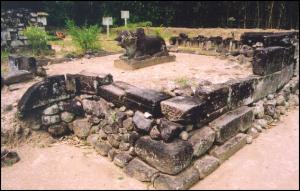 Characteristics:The
temple complex of ruins has a size of 50 mx 50 m made of andesite rock
types, and here in 1879 found that many inscriptions Canggal we know
today. Besides
Canggal inscription, the temple was once also found yoni altar, statues
phallus (symbol of Lord Shiva), and cow statues or Andini.4. Candi Prambananprambanan
Characteristics:The
temple complex of ruins has a size of 50 mx 50 m made of andesite rock
types, and here in 1879 found that many inscriptions Canggal we know
today. Besides
Canggal inscription, the temple was once also found yoni altar, statues
phallus (symbol of Lord Shiva), and cow statues or Andini.4. Candi Prambananprambanan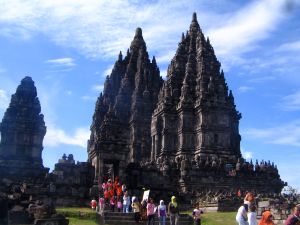 Standing under the largest Hindu temple in Southeast Asia selarik poem suddenly came to mindPrambanan
temple is also known as the Jonggrang save a legend that became staple
reading in school books for elementary school children. Bondowoso story of the Kingdom Pengging who wanted to marry a beautiful virgin named Jonggrang. The daughter politely refuse. He requires 1000 temples made overnight. Bandung who has supernatural powers necessarily agree. It's almost a thousand temples were built when the princess sly sense not to interfere. Bandung is disappointed Jonggrang be cursed statue, which is believed to be Batari Durga statue in one of the temples.5. Candi Gunung Saritemple-barongTemple Gunung Sari is one of the Hindu Shiva temple in Java. This temple site adjacent to the Temple Mount where the discovery of the inscription Canggal Wukir.
Standing under the largest Hindu temple in Southeast Asia selarik poem suddenly came to mindPrambanan
temple is also known as the Jonggrang save a legend that became staple
reading in school books for elementary school children. Bondowoso story of the Kingdom Pengging who wanted to marry a beautiful virgin named Jonggrang. The daughter politely refuse. He requires 1000 temples made overnight. Bandung who has supernatural powers necessarily agree. It's almost a thousand temples were built when the princess sly sense not to interfere. Bandung is disappointed Jonggrang be cursed statue, which is believed to be Batari Durga statue in one of the temples.5. Candi Gunung Saritemple-barongTemple Gunung Sari is one of the Hindu Shiva temple in Java. This temple site adjacent to the Temple Mount where the discovery of the inscription Canggal Wukir.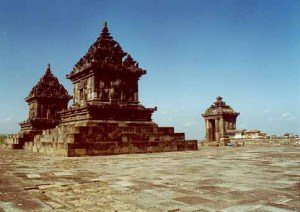 Characteristics:Candi Gunung Sari views of ornament, shape, and architecture likely older than the Temple Mount Wukir. In Puncak Gunung Sari we could see the scenery is stunning and amazing. The temple is situated in the village of Gunung Sari Gulon, Salam subdistrict, Magelang regency, Central Java Province. Hopefully
in the future Temple Gunung Sari increasingly recognized by many people
to be able to find inspiration and keindahanny.6. Arca Gupoloarca-gupolo
Characteristics:Candi Gunung Sari views of ornament, shape, and architecture likely older than the Temple Mount Wukir. In Puncak Gunung Sari we could see the scenery is stunning and amazing. The temple is situated in the village of Gunung Sari Gulon, Salam subdistrict, Magelang regency, Central Java Province. Hopefully
in the future Temple Gunung Sari increasingly recognized by many people
to be able to find inspiration and keindahanny.6. Arca Gupoloarca-gupolo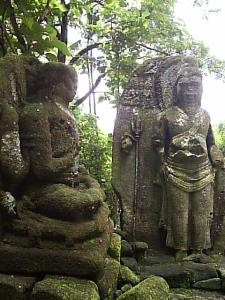 Gupolo
Arca is a collection of 7 statues of Hindu religion characterized by
lies near the temple and temple Ijo Barong, in the region Sambirejo
village, Prambanan district, Yogyakarta. Gupolo is the nickname of the local population against Agastya statues found in the area of the site. Although
the form of 2 meter high statue of Agastya is now not so clear, but the
Trident weapons as a symbol of the god Shiva in his hand is still
clearly visible. Several other statues, most of whom are Hindu deity statue in a sitting position.Characteristics:Gupolo
near statues are in the form of crystal clear spring water wells used
by the locals to take the water, and despite the long dry season of this
well is never dry. According
to local folk legend, is the name of the duke Gupolo (prime minister)
of the Boko king immortalized as the name Ratu Boko temple (the father
of the goddess Loro Jonggrang Prambanan temple in the legend).7. Candi Cangkuangtemple-Cangkuang
Gupolo
Arca is a collection of 7 statues of Hindu religion characterized by
lies near the temple and temple Ijo Barong, in the region Sambirejo
village, Prambanan district, Yogyakarta. Gupolo is the nickname of the local population against Agastya statues found in the area of the site. Although
the form of 2 meter high statue of Agastya is now not so clear, but the
Trident weapons as a symbol of the god Shiva in his hand is still
clearly visible. Several other statues, most of whom are Hindu deity statue in a sitting position.Characteristics:Gupolo
near statues are in the form of crystal clear spring water wells used
by the locals to take the water, and despite the long dry season of this
well is never dry. According
to local folk legend, is the name of the duke Gupolo (prime minister)
of the Boko king immortalized as the name Ratu Boko temple (the father
of the goddess Loro Jonggrang Prambanan temple in the legend).7. Candi Cangkuangtemple-Cangkuang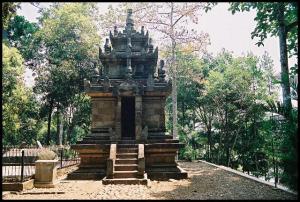 Cangkuang temple is a Hindu temple located in Kampung Pulo, Cangkuang area, District Leles, Garut, West Java. The temple is also the first to be found in Tatar Sunda and is the only Hindu temple in Tatar Sunda.Characteristic of his:Cangkuang temple building that now can we see the result of the restoration which was inaugurated in 1978. This temple stands on a rectangular area measuring 4.7 x 4.7 m with a height of 30 cm. Foot building which underpins seam lotus, kumuda seam, and seam pasagi size 4.5 x 4.5 m with a height of 1.37 m. On the east side there is a ladder up the place the viewer in length 1.5 m and width of 1.26 m.8. Gedong Songotemple-Songo-gedong
Cangkuang temple is a Hindu temple located in Kampung Pulo, Cangkuang area, District Leles, Garut, West Java. The temple is also the first to be found in Tatar Sunda and is the only Hindu temple in Tatar Sunda.Characteristic of his:Cangkuang temple building that now can we see the result of the restoration which was inaugurated in 1978. This temple stands on a rectangular area measuring 4.7 x 4.7 m with a height of 30 cm. Foot building which underpins seam lotus, kumuda seam, and seam pasagi size 4.5 x 4.5 m with a height of 1.37 m. On the east side there is a ladder up the place the viewer in length 1.5 m and width of 1.26 m.8. Gedong Songotemple-Songo-gedong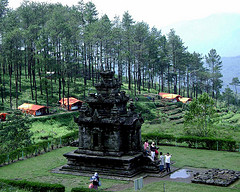 Gedong
Songo is the name of a complex of buildings of cultural heritage Hindu
temple located in the village temple, Ambarawa district, Semarang
regency, Central Java, Indonesia precisely at the slopes of Mount
Ungaran. In the temple complex there are five temples.The
temple was discovered by Raffles in 1804 and is the cultural heritage
of the Hindu dynasty era dynasty 9th century (927 years BC).Characteristics:This temple has similarities with the Dieng temple complex in Wonosobo. The
temple is situated at an altitude of about 1,200 m above sea level so
the air temperature is cold enough here (ranging between 19-27 ° C)Location 9 temples scattered on the slopes of Mount Unggaran has beautiful natural scenery. Around the site there is also a neat pine forests and springs that contain sulfur.9. Candi PringapusPringapus
Gedong
Songo is the name of a complex of buildings of cultural heritage Hindu
temple located in the village temple, Ambarawa district, Semarang
regency, Central Java, Indonesia precisely at the slopes of Mount
Ungaran. In the temple complex there are five temples.The
temple was discovered by Raffles in 1804 and is the cultural heritage
of the Hindu dynasty era dynasty 9th century (927 years BC).Characteristics:This temple has similarities with the Dieng temple complex in Wonosobo. The
temple is situated at an altitude of about 1,200 m above sea level so
the air temperature is cold enough here (ranging between 19-27 ° C)Location 9 temples scattered on the slopes of Mount Unggaran has beautiful natural scenery. Around the site there is also a neat pine forests and springs that contain sulfur.9. Candi PringapusPringapus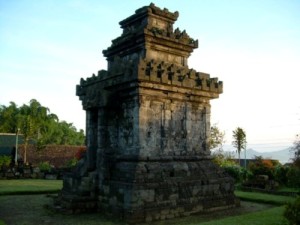 The
temple is a temple in the village Pringapus Pringapus, Ngadirejo,
Waterford 22 km northwest of the capital toward the Waterford district. Hindu statues berartistik a close relation to indicate that the temple of Lord Shiva is the Hindu sect Pringapus Siwaistis. The
temple was built in the year 772 C or 850 AD according to the
inscriptions found around the temple when the restoration was held in
1932.Characteristics:This temple is a replica Mahameru, the name of a mountain abode of the gods. This is evidenced by the presence of ornate Antefiq and Relief depicting Hapsara-hapsari demi god. Pringapus temple is Hindu sect Siwaistis10. Sukuhtemple-SukuhSukuh is a Hindu temple complex located in Karanganyar, ex Surakarta, Central Java. This temple is categorized as a Hindu temple for the discovery of linga and yoni cult object. The
temple is classified as controversial because of the less common and
because of the many objects that symbolize the phallus and yoni
sexuality.Traits-characteristics:Sukuh building gives the impression of simplicity is striking at the visitors. Impression
one gets from this temple is quite different to that obtained from the
large temples in Central Java is Borobudur and Prambanan. Sukuh building forms tend to be similar to the cultural heritage in Mexico Mayan or Inca cultural heritage in Peru. This structure also remind visitors of the forms of the pyramids in Egypt.
The
temple is a temple in the village Pringapus Pringapus, Ngadirejo,
Waterford 22 km northwest of the capital toward the Waterford district. Hindu statues berartistik a close relation to indicate that the temple of Lord Shiva is the Hindu sect Pringapus Siwaistis. The
temple was built in the year 772 C or 850 AD according to the
inscriptions found around the temple when the restoration was held in
1932.Characteristics:This temple is a replica Mahameru, the name of a mountain abode of the gods. This is evidenced by the presence of ornate Antefiq and Relief depicting Hapsara-hapsari demi god. Pringapus temple is Hindu sect Siwaistis10. Sukuhtemple-SukuhSukuh is a Hindu temple complex located in Karanganyar, ex Surakarta, Central Java. This temple is categorized as a Hindu temple for the discovery of linga and yoni cult object. The
temple is classified as controversial because of the less common and
because of the many objects that symbolize the phallus and yoni
sexuality.Traits-characteristics:Sukuh building gives the impression of simplicity is striking at the visitors. Impression
one gets from this temple is quite different to that obtained from the
large temples in Central Java is Borobudur and Prambanan. Sukuh building forms tend to be similar to the cultural heritage in Mexico Mayan or Inca cultural heritage in Peru. This structure also remind visitors of the forms of the pyramids in Egypt.
bandarq
BalasHapusMarioqq
Kontes SEO
MarioQQ SEO
Bermain Di MarioQQ Membuat Bahagia ?
Cerita Rakyat Indonesia
Berita Viral
Berita Terkini
Lucinta Luna Hamil!
Marioqq
bandarq
agen bandarq
domino99
aduq
bandar66
kakek gokil
Situs Bandarq Marioqq Terbaik
AsiaTaipan
berita gokil